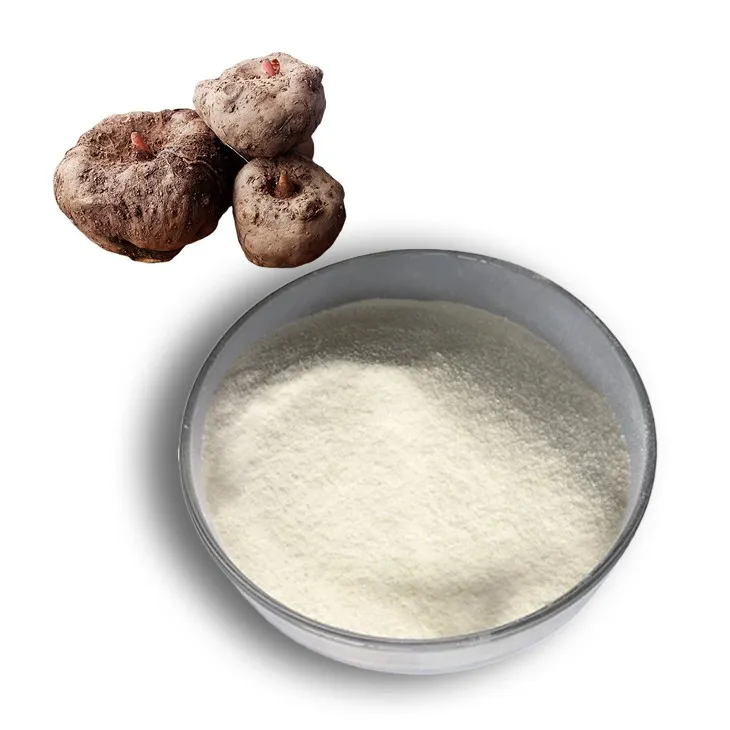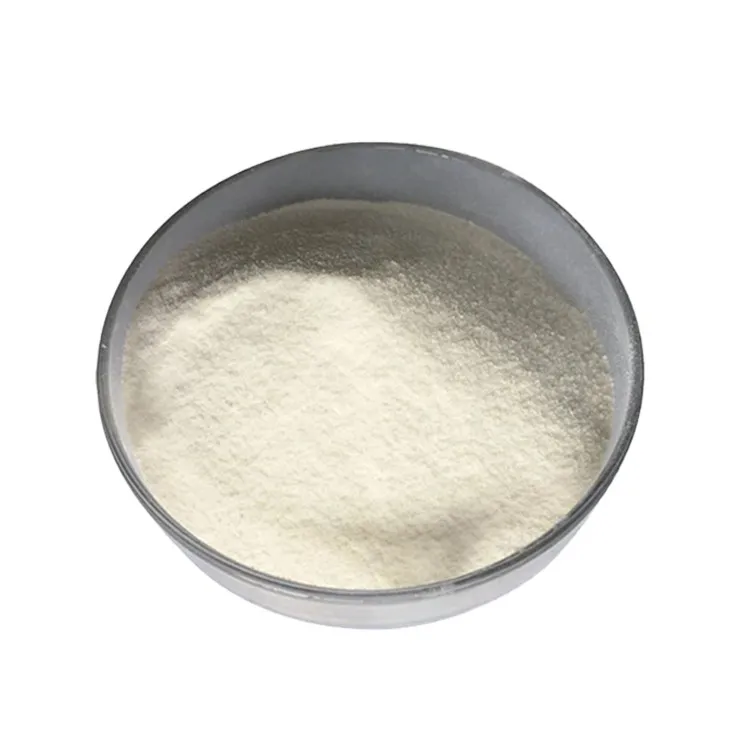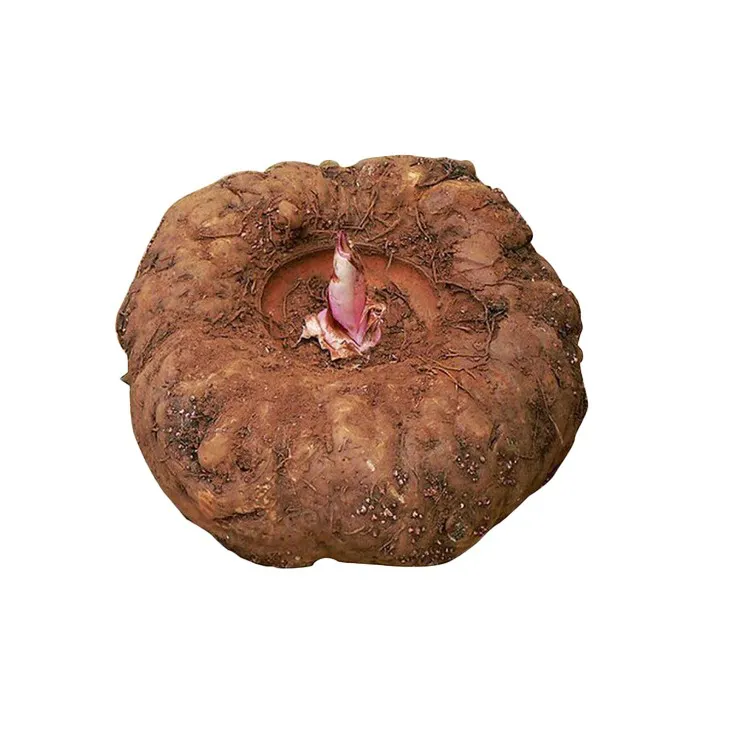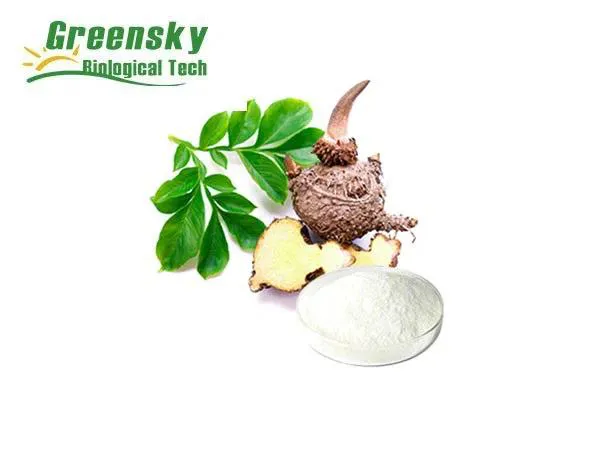- 0086-571-85302990
- sales@greenskybio.com
The process of extracting konjac glucomannan from konjac powder.
2024-11-30

1. Introduction
Konjac flour is a valuable raw material, as it contains konjac glucomannan (KGM), a polysaccharide with remarkable properties. KGM has a wide range of applications, from being a thickener in the food industry to having potential health - promoting effects in medicine. Therefore, the extraction of KGM from konjac flour is of great significance.

2. Sample Preparation of Konjac Flour
2.1 Cleaning and Drying
The first step in sample preparation is to ensure the quality of the konjac flour. The konjac flour needs to be carefully cleaned to remove any impurities such as dirt, stones, or other foreign particles. This can be done by sifting the flour through a fine - meshed sieve. After cleaning, the konjac flour should be dried. Drying is crucial as it helps to reduce the moisture content, which can affect the extraction process later. The drying process can be carried out at a suitable temperature, usually between 40 - 60°C, until the moisture content is reduced to an acceptable level, typically around 10 - 15%.2.2 Grinding and Sieving (if necessary)
If the konjac flour is in large lumps or not in a fine enough powder form, it may need to be ground further. Grinding can be done using a mortar and pestle or a mechanical grinder. After grinding, the flour should be sieved again to ensure a uniform particle size. A fine - meshed sieve, for example, with a pore size of around 100 - 200 mesh, can be used to obtain a smooth and consistent konjac flour sample for the extraction process.
3. Extraction Methods: Combining Chemical and Physical Approaches
3.1 Chemical Methods
- Alkaline Treatment: One of the common chemical methods used in KGM extraction is alkaline treatment. Konjac flour is mixed with an alkaline solution, such as sodium hydroxide (NaOH). The alkaline environment helps to break down the cell walls of the konjac flour, making it easier to release the KGM. The concentration of the NaOH solution can vary, but typically it is in the range of 0.5 - 2.0 mol/L. The mixture is then stirred at a certain temperature, usually around 30 - 50°C, for a specific period, which can be from 1 - 3 hours.
- Enzymatic Hydrolysis: Enzymes can also be used in the extraction process. For example, cellulase or hemicellulase can be added to the konjac flour suspension. These enzymes break down the cellulose and hemicellulose components in the flour, which are associated with the KGM. The enzymatic hydrolysis is carried out under specific conditions of pH (usually around 4 - 6) and temperature (around 40 - 50°C). The enzyme concentration and the reaction time also need to be optimized. For instance, the enzyme concentration can be in the range of 0.1 - 1.0% (w/v) and the reaction time can be from 2 - 6 hours.
3.2 Physical Methods
- Microwave - Assisted Extraction: Microwave technology can be applied to enhance the extraction of KGM. In this method, the konjac flour sample, after being mixed with a suitable solvent (such as water or a buffer solution), is exposed to microwave radiation. The microwave energy heats the sample rapidly and uniformly, which can increase the mass transfer rate and the extraction efficiency. The power of the microwave can be set at different levels, for example, from 300 - 800 W, and the extraction time can be from 5 - 15 minutes.
- Ultrasonic - Assisted Extraction: Ultrasonic waves can also be used to assist in KGM extraction. When ultrasonic waves are applied to the konjac flour - solvent mixture, they create cavitation bubbles. These bubbles collapse, generating high - pressure and high - temperature micro - environments, which can disrupt the cell structure of the konjac flour and promote the release of KGM. The ultrasonic frequency can be in the range of 20 - 50 kHz, and the extraction time can be from 10 - 30 minutes.

4. Filtration and Centrifugation: Separating KGM from Other Substances
4.1 Filtration
After the extraction process, the resulting mixture contains KGM along with other substances such as unreacted konjac flour particles, enzymes (if used), and reaction by - products. Filtration is the first step in separating KGM. A filter paper or a membrane filter can be used. For a coarse separation, a regular filter paper with a medium porosity can be employed. However, for a more refined separation, a membrane filter with a smaller pore size, such as a microfiltration membrane with a pore size of 0.1 - 1.0 μm, may be necessary. The filtration process is carried out under normal pressure or with a gentle vacuum to avoid damaging the KGM structure.4.2 Centrifugation
Centrifugation is another important step in the purification of KGM. After filtration, the filtrate may still contain some fine particles or substances that are difficult to separate by filtration alone. The filtrate is placed in a centrifuge tube and centrifuged at a certain speed. The centrifugal speed can range from 3000 - 10000 rpm, depending on the nature of the impurities and the desired purity of the KGM. Centrifugation helps to sediment the remaining particles at the bottom of the tube, while the purified KGM remains in the supernatant. The supernatant can then be carefully collected for further processing or analysis.
5. Applications of the Extracted KGM
5.1 In the Food Industry
As a thickener, KGM has excellent properties. It can be used in a variety of food products such as dairy products, sauces, and baked goods. In dairy products like ice cream, KGM can improve the texture, prevent ice crystal formation, and increase the viscosity. In sauces, it can provide a smooth and consistent texture, preventing separation. In baked goods, it can retain moisture, resulting in a softer and more moist product.5.2 In the Medical Field
KGM has potential health - promoting effects. It has been studied for its role in reducing cholesterol levels in the body. It can also act as a prebiotic, promoting the growth of beneficial gut bacteria. Additionally, in some medical applications, KGM - based gels can be used for drug delivery systems, as they can encapsulate drugs and release them in a controlled manner.5.3 In Other Industries
KGM also finds applications in the cosmetic industry. It can be used in skin care products as a moisturizer and thickening agent. In the textile industry, it can be used as a sizing agent to improve the quality of fabrics. Moreover, in the paper industry, it can be used to improve the strength and water - resistance of paper.
6. Conclusion
The extraction of konjac glucomannan from konjac flour is a complex but important process. Through proper sample preparation, a combination of chemical and physical extraction methods, and effective filtration and centrifugation steps, high - quality KGM can be obtained. The extracted KGM has great potential in various industries, making it a valuable product worthy of further research and development.
FAQ:
What are the main steps in the extraction process of konjac glucomannan from konjac flour?
The extraction process starts with sample preparation of the konjac flour. Then chemical and physical methods are combined for extraction. After that, filtration and centrifugation are important for separating KGM from other substances.
Why are both chemical and physical methods used in the extraction of konjac glucomannan?
Combining chemical and physical methods can help to more effectively extract konjac glucomannan from konjac flour. Physical methods may be used for initial separation or breakdown, while chemical methods can help in further isolation and purification of the KGM.
What is the role of filtration in the extraction of konjac glucomannan?
Filtration is crucial in the extraction process as it helps to separate the konjac glucomannan from other solid particles or impurities that may be present in the mixture after the extraction step using chemical and physical methods.
How does centrifugation contribute to the extraction of konjac glucomannan?
Centrifugation is used to separate the konjac glucomannan from other substances based on differences in density. It can help in obtaining a more purified form of KGM by removing substances with different densities from the KGM - containing solution.
What are the potential applications of the refined konjac glucomannan?
The refined KGM has great potential in various fields. In the food industry, it can be used as a thickener. In medicine, it has health - promoting effects.
Related literature
- Konjac Glucomannan: Properties and Applications"
- "Extraction and Characterization of Konjac Glucomannan: A Review"
- "Konjac Glucomannan in Food and Biomedical Applications: An Overview"
- ▶ Hesperidin
- ▶ citrus bioflavonoids
- ▶ plant extract
- ▶ lycopene
- ▶ Diosmin
- ▶ Grape seed extract
- ▶ Sea buckthorn Juice Powder
- ▶ Beetroot powder
- ▶ Hops Extract
- ▶ Artichoke Extract
- ▶ Reishi mushroom extract
- ▶ Astaxanthin
- ▶ Green Tea Extract
- ▶ Curcumin Extract
- ▶ Horse Chestnut Extract
- ▶ Other Problems
- ▶ Boswellia Serrata Extract
- ▶ Resveratrol Extract
- ▶ Marigold Extract
- ▶ Grape Leaf Extract
- ▶ blog3
- ▶ blog4
-
The Most Highly - Praised Seabuckthorn Oil.
2024-11-30
-
Wholesale Acai Berry Extract Suppliers.
2024-11-30
-
The best artichoke leaf extract from nature.
2024-11-30
-
Optimal Bioavailability of Green Tea Extract
2024-11-30
-
The best lemon extract on the market.
2024-11-30
-
Active ingredients in kelp extract powder.
2024-11-30
-
How to make powder from hawthorn extract?
2024-11-30
-
Longan Extract
2024-11-30
-
Yohimbine Bark Extract
2024-11-30
-
Wheat Germ Extract
2024-11-30
-
Tongkat Ali Extract Powder
2024-11-30
-
Black Rice Extract
2024-11-30
-
Hawthorn powder
2024-11-30
-
Genistein
2024-11-30
-
Polygonum multiflorum extract
2024-11-30
-
Chaste Berry Extract
2024-11-30
-
Hericium erinaceus extract powder
2024-11-30





















